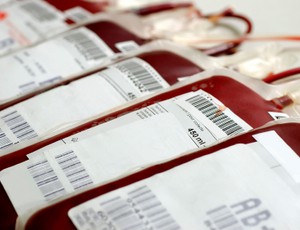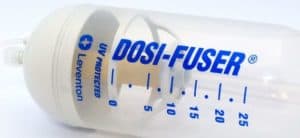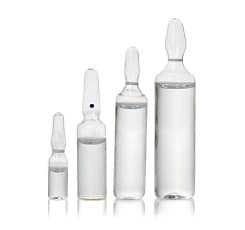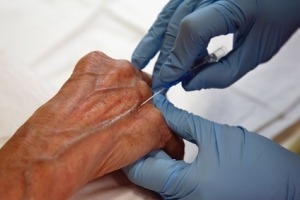Transporting blood components through a pneumatic tube system

“The PTS was considered a fast, safe and reliable means of transportation for blood components, also securing quality prerequisites” Garcia et al (2021).
Taurolidine-citrate catheter lock in home parenteral nutrition

“The use of taurolidine-citrate locks in HPN paediatric patients has reduced the number of CLABSIs” Puppi et al (2021).
Alternative vascular access in superior vena cava syndrome

“Our aim is to report the results of Non-conventional Vascular Accesses (NCVA) management as part of IF comprehensive multidisciplinary care and conduct a systematic review to understand the current available knowledge” Perez Illidge et al (2021).
Dalbavancin off-label treatment – Full Text

“Dalbavancin was shown to have an excellent tolerability profile and to be a highly successful therapeutic approach even in those cases treated off-label” Brescini metal (2021).
Vascular access for extracorporeal life support

“An ECMO nursing protocol for cannulae management providing sutureless devices for cannula and tubing securement allows safe line stabilization, with the potential to reduce complications related to ECMO vascular access” Lucchini et al (2021).
Vancomycin infusion reaction terminology

“Five months after the transition from 1 electronic health record to another at our freestanding children’s hospital, our antimicrobial stewardship team reviewed all active allergy records to identify and then replace use of RMS terminology with preferred alternative vancomycin flushing syndrome” Konold et al (2021).
Long peripheral catheters in neonates

“In our experience, 2 Fr 4-6 cm long peripheral catheters may be a valid option for neonates requiring peripherally compatible infusions for more than 3 days” Romitti et al (2021).
Ceftazidime stability in elastomeric pumps

“For the solution with a starting dose of 7 g of ceftazidime, 10% degradation was observed after an average of 18h42min” Nguyen et al (2021).
OPAT antimicrobial stewardship – Full Text

“As more focus is placed on outpatient antimicrobial stewardship, clinicians practicing in OPAT should publish more data regarding OPAT program methods and outcomes as they relate to antimicrobial stewardship” Mahoney et al (2021).
CVAD removal in patients with Haemophilia A

“We propose that, in the era of emicizumab, prophylactic factor administration pre-operatively for elective CVAD removal is not required in the majority of cases” Swan et al (2021)
Heparin lock and KiteLock comparison

“We found KiteLock to be cost-effective in preventing CLABSIs in paediatric IF” Gattini et al (2021).
Taurolidine lock solutions

“To provide an updated overview of randomized controlled trials (RCT) comparing the efficacy of taurolidine containing lock solutions (TL) to other lock solutions for the prevention of CVC-related bloodstream infections in all patients populations” van den Bosch et al (2021).
Brachial plexus injury following CVC insertion

“We reported a case of kyphoscoliosis deformity corrective surgery where IJV cannulation led to brachial plexus injury and was eventually recovered with medications and physiotherapy” Modi et al (2021).
Early extravasation detection – Full Text

“Sensors of millimeter size were printed in an array and were used for multiple detection points in a large area to detect extravasation at small volumes (<0.5 mL) at accurate bump location" Lu and Liao (2021).
Bacterial contamination of lightproof covers

“These results indicate that there is a risk of bacterial contamination in the reuse of lightproof covers and that they should either be disposed off properly after usage or hand, finger disinfectants should be used while handling them to prevent any possible contamination” Hosomi et al (2021).
Extending lifespan of central venous access devices

“This allows the development of a robust tailored care plan, which prolongs the life of a CVAD and in turn preserves venous access” Cole et al (2021).
IV ports in sickle cell disease

“Infusion ports in patients with SCD was associated with low rates of thrombosis, infection, and malfunction, and may be considered as an alternative to frequent intravenous access, especially in patients requiring CT” Ilonze et al (2021).
Catheter lock solutions and biofilm

“An in vitro model allows studies on the mechanisms by which the lock solutions exert their antimicrobial effects on catheter-associated biofilm, thus providing a better understanding of the management of devise-associated infections” Colombari et al (2021).
Vancomycin associated cutaneous drug reactions – Full Text

“We discuss different types of vancomycin-associated cutaneous drug reactions. We also review the literature regarding previous descriptions of this type of drug reaction, known as transient reactive phlebitis (TRP)” Azimi-Ghomi and Napier (2021).
Continuous infusion administration protocol for PipTaz

“Administration of continuous infusion PIP/TAZ appears to be a viable mitigation strategy during small volume fluid shortages” Tschumper et al (2021).
Intraosseous use in children

“While IO placement is uncommonly performed pre-hospital, in critical situations there is a high success rate” Ting et al (2021).
Defining difficult intravenous access

“Considering the themes identified, an evidence-driven definition of DIVA is proposed: “when a clinician has two or more failed attempts at PIV access using traditional techniques, physical examination findings are suggestive of DIVA (e.g. no visible or palpable veins) or the patient has a stated or documented history of DIVA” Bahl et al (2021).
Catheter salvage is possible in >75% CLABSI

“Catheter salvage is possible in >75% CLABSIs. Effective antibiotic treatment without removal of the CVC should be considered as first line treatment and a single-lumen CVC should be the catheter of first choice” D’Eusebio et al (2021).
Potassium chloride extravasation – Full Text

“Report the clinical course of a patient who was suffering a potassium extravasation and to discuss steps that can be done to decrease the chances of this event from occurring in other patients” Yan (2021).
Cost effectiveness of ethanol lock CLABSI prophylaxis

“At the current price, ethanol lock therapy is not cost-effective for CLABSI prevention in children with intestinal failure in the United States” Raghu et al (2021).
Rare CVC complication

“We present this rare CVC complication to demonstrate the possibility of incorrect insertion of the catheter and penetration of the spinal canal, possibly causing neuronal damage” Chang et al (2021).
Early CVC removal and CLABSI recurrence

“A lower incidence of infection-related mortality, persistent bacteremia, and recurrent bacteremia was found in patients early catheter removal; however the sample size was not adequate to detect statistical differences” Johns et al (2021).
Local anaesthetic for peripheral IV cannulation

“Among healthy individuals undergoing elective PVC, EMLA was associated with reduced pain, increased satisfaction, and was the preferred treatment compared to Coolsense” Thind et al (2021).
Vancomycin in critically ill children – Full Text

“Studies to assess the factors responsible for this variability in vancomycin pharmacokinetics are needed” Akunne et al (2021).
Transient bacteremia promotes catheter related thrombosis

“Therefore, transient bacteremia could be a silent trigger that induces NET-related immunothrombosis enhancing catheter-related central venous stenosis” Chen et al (2021).

